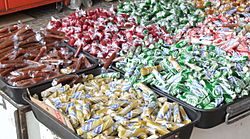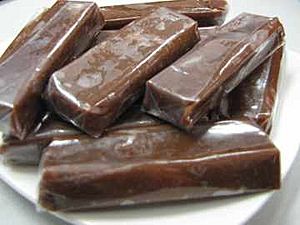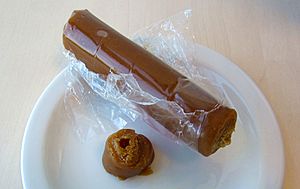Dodol facts for kids

Assorted Garut dodols, the most popular variant of Dodol, on display in Bandung
|
|
| Type | Confectionery |
|---|---|
| Place of origin | Indonesia |
| Region or state | Southeast Asia and Indian subcontinent |
| Main ingredients | Coconut milk, jaggery, rice flour |
Dodol is a yummy, sweet treat that's a bit like toffee. It's made from sugar palm and is very popular in Southeast Asia and the Indian subcontinent. Dodol first came from Indonesia. Today, you can find it in many countries. These include Malaysia, Singapore, Brunei, the Philippines, Sri Lanka, Thailand, and Myanmar. In Myanmar, it's called mont kalama. Dodol is known for being sticky, thick, and super sweet. It's made with coconut milk, a special sugar called jaggery, and rice flour.
Contents
Dodol: A Sweet History
Dodol has a very long history! It was even mentioned in an old stone carving from the year 930 CE. This carving was found in Indonesia and talks about "dwadwal" as a snack.
The story of dodol is linked to its main ingredients. These are gula aren, which is palm sugar from the Arenga pinnata plant, and rice flour. Dodol is one of the oldest traditional sweets from Maritime Southeast Asia. We don't know the exact place where dodol first appeared. But many different versions are found across Java and Sumatra. The word "Dodol" comes from the Sundanese language. In Javanese language, it's called jenang.
Dodol likely traveled to Southern India and Sri Lanka with people who moved from Indonesia. Some also think the Portuguese, who were in Sri Lanka long ago, might have introduced it. In Sri Lanka, there are special dodol recipes like kalu dodol. Dodol is also very famous in Kilakarai, Tamil Nadu, possibly brought by Muslim immigrants from Sri Lanka.
Dodol's Cultural Importance
Dodol is a special treat in many cultures.
Festivals and Celebrations
In countries like Indonesia and Malaysia, where most people are Muslim, dodol is often served during big festivals. These include Eid ul-Fitr and Eid al-Adha. It's a sweet snack for everyone, especially children. The Betawi people in Indonesia love making dodol at home for Lebaran (Eid ul-Fitr). Families get together to make it, which is a fun tradition. There's even a place in South Jakarta, Pasar Minggu, known for traditional homemade Betawi dodol.
Dodol is also popular among Roman Catholics in parts of India, like Goa and Mumbai. A company called Dodol Hj Ideris even sells dodol in the Middle East.
Philippines Traditions
In the Philippines, people in Paoay, Ilocos Norte, celebrate the Guling-Guling Festival. Dodol, or "dudol" as they call it, is a main food during this festival. It's an old tradition from the Spanish times, celebrated before Ash Wednesday. This is the last day for fun before the serious Lenten season. Locals dress up, and there are street parties, cultural shows, and a food fair. The festival starts with a ritual called “Guling,” where the town mayor used to mark people's foreheads with a white cross.
A similar Filipino dessert is called kalamay. It uses sugarcane sugar instead of palm sugar. Kalamay is also more liquid and uses ground glutinous rice instead of rice flour. But the main ingredients and how they are made are similar.
In the Ilocos Region of the Philippines, dudol is a symbol of their food heritage. It means sticking together and helps families feel closer. Ilocano dudol is made from "diket" rice flour, coconut milk, and "benńal" sugarcane juice.
In the southern Philippines, in Mindanao and the Sulu Archipelago, dodol or dudul is very much like the Indonesian and Malaysian versions. It's usually shaped into thick cylinders wrapped in corn husks or colorful plastic. Then it's cut into disks to serve. Filipino dodol uses ground glutinous rice paste and muscovado sugarcane sugar, not palm sugar.
How Dodol is Made

Dodol is made from coconut milk, jaggery (palm sugar), and rice flour. It's a sticky, thick, and sweet treat. Making dodol takes a lot of time and effort. The ingredients are cooked in a big pot, often for up to 9 hours! As it cooks, the liquid evaporates, and the mixture becomes thicker.
The most important part is that the dodol must be stirred constantly. If you stop stirring, it can burn, which would ruin the taste and smell. Dodol is ready when it's firm and doesn't stick to your fingers when you touch it.
Different Kinds of Dodol
There are many different kinds of dodol, especially in Indonesia.
Indonesian Dodol Varieties
The town of Garut in West Java is a big center for making dodol in Indonesia. You can find many flavors there. One popular flavor is durian, called lempuk, which is loved in Sumatra. Some makers in Garut even add chocolate to make a special 'chocodot' (chocolate dodol) as a souvenir.
Here are some other interesting dodol flavors:
- Dodol bengkoang has jicama in it.
- Dodol kacang hijau is made with mung beans.
- Dodol tape uses tapai, which is a fermented rice product.
- Dodol ubi talam contains yam.
- Dodol sirsak has soursop fruit.
- Dodol nangka includes jackfruit.
- Dodol lidah buaya is made with aloe vera.
- Dodol apel Malang is a specialty from Malang city. It's made with apple!
- Dodol susu comes from Pangalengan, Bandung. It contains milk.
- Dodol tomat is made with tomato.
- Dodol salak contains salak fruit.
- Dodol rumput laut is made with seaweed.
- Dodol pisang has banana.
- Dodol nenas includes pineapple.
- Dodol mangga is made with mango.
- Dodol China is an Indonesian Chinese version of sweet nian gao with rich coconut sugar.
- Dodol Betawi is made by the Betawi people in Jakarta. It uses a mix of white and black glutinous rice.
Dodol in Everyday Talk
In casual Indonesian talk, the word "dodol" can sometimes be used as slang. It can mean 'stupid' or 'illogical'. But it's not polite to call someone "dodol."


